Digital Poster
Advances in Parkinson's Disease Imaging I
Joint Annual Meeting ISMRM-ESMRMB & ISMRT 31st Annual Meeting • 07-12 May 2022 • London, UK

| Computer # | ||||
|---|---|---|---|---|
2265 |
1 | Brain-wide olfactory aberrations in a Parkinson’s Disease mouse model revealed by functional MRI
Ruxanda Lungu1, Francisca F Fernandes1, Tiago Fleming Outeiro2, and Noam Shemesh1
1Shemesh Lab, Champalimaud Foundation, Lisbon, Portugal, 2Experimental Neurodegeneration, University of Goettingen, Goettingen, Germany Parkinson's disease (PD) is associated with irreparable damage to dopaminergic neurons in brain areas involved in movement. Frequently, a very early symptom is an impaired sense of smell, but the associated brain-wide mechanisms remain unclear. Here, we report on aberrations in BOLD-fMRI responses along olfactory pathway in a PD mouse model. We find decreased activation, especially in the main olfactory bulb, olfactory tubercle and piriform cortex in PD mice when compared to healthy controls upon olfactory stimulation. |
||
2266 |
2 | High reproducibility of sandwich spatial saturation neuromelanin imaging (sandwichNM): multicenter and test-retest results
Sooyeon Ji1, Eun-Jung Choi1, Beomseok Sohn2, Eung Yeop Kim3, Kyoungwon Baik2, Na-Young Shin4, Won-Jin Moon5, Seongbeom Park6, Soohwa Song6, Phil Hyu Lee7, Dong Hoon Shin6, and Jongho Lee1
1Seoul National University, Seoul, Korea, Republic of, 2Severance Hospital, Seoul, Korea, Republic of, 3Department Radiology, Samsung Medical Center, Seoul, Korea, Republic of, 4Department Radiology, Catholic University of Korea, Seoul, Korea, Republic of, 5Department of Radiology, Konkuk University Medical Center, Seoul, Korea, Republic of, 6Heuron Co. Ltd., Incheon, Korea, Republic of, 7Department of Neurology, Severance Hospital, Seoul, Korea, Republic of
The reproducibility of the recently proposed sandwich spatial saturation neuromelanin (sandwichNM) imaging, which uses product sequences, is evaluated by a multi-center/multi-vendor traveling-subject study. Additionally, test-retest scans acquiring data in two different days are performed and evaluated. When compared to a conventional MT-weighted GRE NM imaging method, sandwichNM demonstrates higher contrast ratios and smaller variations across scanners, and higher intra-class coefficient and lower coefficient of variation in the test and retest scans, revealing higher reproducibility over the conventional method.
|
||
2267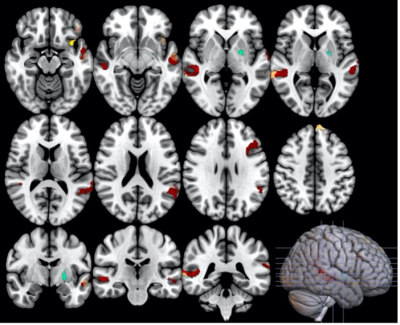 |
3 | Brain correlates of voice disorders in early Parkinson’s disease
Laetitia Jeancolas1,2, Sandy Mournet1,2,3,4, Cécile Gallea1,2, Emma Biondetti1,2, Graziella Mangone3,5,6, Lydia Chougar1,2,3,4, Nicolas Villain7, Rahul Gaurav1,2, Habib Benali8, Badr-Eddine Benkelfat9, Isabelle Arnulf3,10, Marie-Odile Habert3,11, Dijana Petrovska-Delacrétaz9, Marie Vidailhet2,3,6, Jean-Christophe Corvol3,5,6, and Stéphane Lehéricy1,2,3,4
1Centre de NeuroImagerie de Recherche – CENIR, Institut du Cerveau – ICM, Paris, France, 2Team “Movement Investigations and Therapeutics”(MOV'IT), Institut du Cerveau – ICM, Paris, France, 3Sorbonne University, Inserm, CNRS, Paris Brain Institute - ICM, Paris, France, 4Department of Neuroradiology, AP-HP, Pitié-Salpêtrière Hospital, Paris, France, 5Clinical Investigation Center for Neurosciences, Pitié-Salpêtrière Hospital, INSERM, Paris, France, 6Department of Neurology, AP-HP, Pitié-Salpêtrière Hospital, Paris, France, 7AP-HP, Pitié-Salpêtrière Hospital, Paris, France, 8PERFORM Centre, Electrical & Computer Engineering Department, Concordia University, Montreal, QC, Canada, 9Laboratoire SAMOVAR, Télécom SudParis, Institut Polytechnique de Paris, Paris, France, 10Sleep disorders unit, AP-HP, Pitié-Salpêtrière Hospital, Paris, France, 11Department of Nuclear Medicine, AP-HP, Pitié-Salpêtrière Hospital, Paris, France
We studied the neural mechanisms underlying Parkinson’s disease (PD) speech impairments. We assessed the relationships between the speech impairment in PD and changes in the nigrostriatal system (DAT imaging and neuromelanin-sensitive MRI) and in resting state fMRI functional connectivity within cortical language networks. Patients presented speech alterations depending on gender. Dopaminergic loss in the striatum as well as functional connectivity between the basal ganglia and the cortex were related to PD speech impairments in men, whereas in women only functional connectivity seemed to play a role in PD speech deterioration.
|
||
2268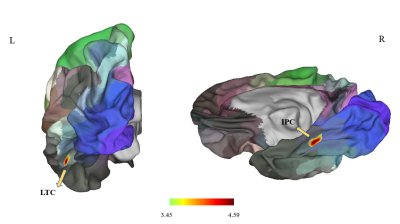 |
4 | Brain Surface Area Alterations Correlate with Gait Impairments in Parkinson’s Disease Video Not Available
Xuan Wei1 and Jinxia Zhu2
1Department of Radiology, Beijing Friendship Hospital, Capital Medical University, Beijing, China, 2MR Collaboration, Siemens Healthcare Ltd., Beijing, China
In this study, we used surface-based morphometry analysis to evaluate the correlation between structural alterations in the brains of Parkinson’s disease (PD) subjects, impaired cognition, and gait. Our results showed that cortical surface area in the left lateral temporal cortex (LTC) and right inferior parietal cortex (IPC) was significantly larger in the PD subjects compared to the healthy subjects. Furthermore, these cortical structural changes were associated with gait impairments in the PD subjects. Therefore, surface area-based analysis is a useful tool for assessing progression of gait impairments in PD subjects.
|
||
2269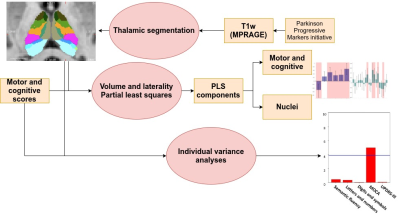 |
5 | Thalamic volume and lateralization on Parkinson Disease associated with cognitive and motor deficits
Vicente Jose Ferrer-Gallardo1, Teresa Esteban-Peñalba2, César Caballero-Gaudes1, and Pedro M Paz-Alonso2
1Signal processing in neuroimaging, Basque Center on Cognition Brain and language, San Sebastian, Spain, 2Language and memory control, Basque Center on Cognition Brain and language, San Sebastian, Spain
This study sheds light on the relationship between the thalamic nuclei volume and their lateralization with cognitive and motor scores in PD. Two partial least squares analyses were performed between the volume or laterality indexes of all nuclei and clinical and cognitive scores. Cognitive deficits in semantic fluency and symbols and digits tests in PD are related to ventral, central and medial thalamic nuclei rather than to specific nuclei differences, except for the right-AV. Motor deterioration seems to be reflected in specific lateralization of the medial and pulvinar areas.
|
||
2270 |
6 | Evaluating iron overload in Nigrosome 1 via Quantitative Susceptibility Mapping at 7T in prodromal stages of Parkinson’s disease
Marta Lancione1,2, Graziella Donatelli2,3, Eleonora Del Prete4, Nicole Campese4, Daniela Frosini4, Matteo Cencini1,2, Mauro Costagli1,5, Giacomo Lucchi6, Michela Tosetti1,2, Massimiliano Godani7, Dario Arnaldi5,8, Michele Terzaghi9,10, Claudio Pacchetti11, Pietro Cortelli12,13, Enrica Bonanni4, Roberto Ceravolo4, and Mirco Cosottini6
1IRCCS Stella Maris, Pisa, Italy, 2Imago7 Research Foundation, Pisa, Italy, 3Neuroradiology Unit, Azienda Ospedaliero-Universitaria Pisana, Pisa, Italy, 4Neurology Unit, Department of Clinical and Experimental Medicine, University of Pisa, Pisa, Italy, 5Department of Neuroscience, Rehabilitation, Ophthalmology, Genetics, Maternal and Child Sciences (DINOGMI), University of Genoa, Genoa, Italy, 6Neuroradiology Unit, Department of Translational Research on New Technologies in Medicine and Surgery, University of Pisa, Pisa, Italy, 7Neurology Unit, Sant'Andrea Hospital, La Spezia, Italy, 8IRCCS Ospedale Policlinico San Martino, Genoa, Italy, 9Unit of Sleep Medicine and Epilepsy, IRCCS Mondino Foundation, Pavia, Italy, 10Department of Brain and Behavioral Sciences, University of Pavia, Pavia, Italy, 11Parkinson's Disease and Movement Disorders Unit, IRCCS Mondino Foundation, Pavia, Italy, 12Clinica Neurologica Rete Metropolitana, IRCCS Istituto Scienze Neurologiche Bologna, Bologna, Italy, 13Department of Biomedical and Neuromotor Sciences (DIBINEM), University of Bologna, Bologna, Italy
iRBD is a prodromal stage of α-synucleinopathies, like PD. Iron deposition is increased in the substantia nigra of PD patients, mainly in Nigrosome-1 (N1). Here, we estimated N1 iron content in PD, iRBD patients and healthy controls using QSM at 7T to investigate group differences and correlation with disease duration. PD patients showed increased N1 susceptibility compared to controls and iRBD patients but no correlation with disease duration. N1 susceptibility in iRBD patients was not different from controls but correlated with disease duration. Hence, in prodromal stages of α-synucleinopathies, QSM can reveal progressive N1 iron accumulation as the disease evolves.
|
||
2271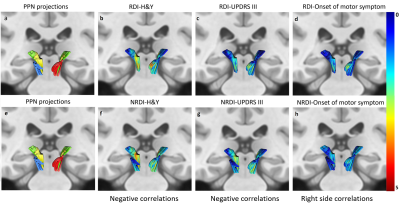 |
7 | Diffusion MRI Connectometry with Motor and Cognitive Deficits of Pedunculopontine Nucleus Cholinergic Projections in Parkinson’s Disease
Pohchoo Seow1, Yao-Chia Shih2, Septian Hartono3, Weiling Lee1, Say Lee Chong1, Celeste Yan Teng Chen 4, Eng King Tan3, and Ling Ling Chan1
1Diagnostic Radiology, Singapore General Hospital, Singapore, Singapore, 2Graduate Institution of Medicine, Yuan Ze University, Taiwan, Taiwan, 3Department of Neurology, National Neuroscience Institute, Singapore, Singapore, 4Neurology, National Neuroscience Institute, Singapore, Singapore
Altered brain cholinergic activity has gained attention in Parkinson’s disease (PD). However, the effects of cholinergic dysregulation on motor and cognitive functions remain unclear. This is partly contributed by the limited capability of conventional MRI techniques to detect microstructural changes in the deep brain. We evaluated the cholinergic projections in 36 PD patients and 58 asymptomatic healthy controls using diffusion MRI connectometry. Local diffusion changes in the cholinergic projections showed significant correlations to motor onset, and clinical motor scores in PD compared to control subjects. Our results suggest underlying neuronal inflammation and compensatory mechanisms in early PD-related neural dysfunction.
|
||
2272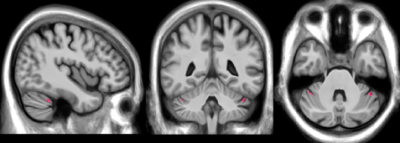 |
8 | Structural and functional correlates of disinhibited behaviors in Essential Tremor
Megan Aumann1, Tony Phan1, Kilian Hett1, Ryan Darby1, and Daniel Claassen1
1Neurology, Vanderbilt University, Nashville, TN, United States
Emerging evidence has implicated the cerebellum in not just motor, but cognitive and behavioral roles in the brain. Previous research in cerebellar diseases have reported impulsive behaviors, but it is unknown if Essential Tremor (ET) patients present with these behaviors and where they localize. Here, in 105 ET patients, we measured disinhibition using the Frontal Systems Behavior Scale (FrSBe) and assessed the relationship between disinhibition scores and grey matter volume in the cerebellum, as well as functional correlates of disinhibition-related grey matter atrophy. These results are the first to evaluate neurobiological changes associated with disinhibition in ET.
|
||
2273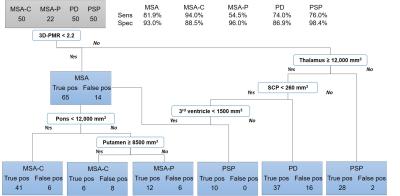 |
9 | Automated 3D MRI Decision Tree to guide referral and diagnosis of parkinsonian disorders
Jisoo Kim1, Andrew S Willett2, Grace F Crotty3, Merlyne Mesidor2, Camden Bay4, Xiaoyin Xu5, Lei Qin6, Vikram Khurana2, and Geoffrey S Young1
1Neuroradiology, Brigham and Women's Hospital, Boston, MA, United States, 2Movement Disorders Division, Neurology, Brigham and Women's Hospital, Boston, MA, United States, 3Neurology, Massachusetts General Hospital, Boston, MA, United States, 4Center for Clinical Investigation, Brigham and Women's Hospital, Boston, MA, United States, 5Diagnostic Radiology, Brigham and Women's Hospital, Boston, MA, United States, 6Imaging, Dana Farber Cancer Institute, Boston, MA, United States
For screening and diagnosis of Parkinson disease (PD), progressive supranuclear palsy (PSP), and multiple system atrophy-parkinsonian/cerebellar subtypes (MSA-P/MSA-C), we propose a two-step decision tree using a novel MRI biomarker and volumetric measures. MRIs from 50 MSA-C, 22 MSA-P, 50 PSP, 50 PD, and 172 age/legal-sex-matched control were used for fully automated volumetric analysis of the brain and brainstem. Sensitivity/specificity for diseased vs control was 90.1/90.7%. Then, a comprehensive tree with the diseased group yielded sensitivity/specificity of 81.9/93.0% (MSA), 94.0/88.5% (MSA-C), 54.5/96.0% (MSA-P), 74.0/86.0% (PD), 76.0/98.4% (PSP). We provide a reproducible and specific diagnostic tool for screening and initial differential diagnosis.
|
||
2274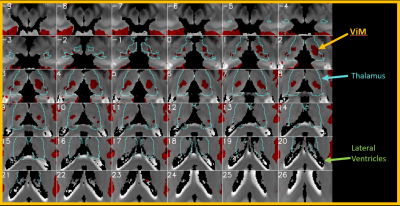 |
10 | 7T resting state connectivity applied to HIFU procedures for planning and efficacy
Mark Lowe1, Jian Lin1, Ajay Nemani1, Sean Nagel2, and Stephen Jones1
1Imaging Institute, Cleveland Clinic, Cleveland, OH, United States, 2Neurosurgery, Cleveland Clinic, Cleveland, OH, United States
High Intensity Focused Ultrasound (HIFU) in now entering clinical practice, for example to treat essential tremor by causing small lesions in the thalamus. Due to small size of treatment lesions, treatment success depends critically on targeting, which is classically done using measurements and landmarks. We explore an alternative method using functional imaging to guide targeting, specifically using 7T resting state connectivity. We present preliminary data of the patterns of connectivity possible with 7T using a concatenated series of 18 healthy subjects.
|
||
The International Society for Magnetic Resonance in Medicine is accredited by the Accreditation Council for Continuing Medical Education to provide continuing medical education for physicians.